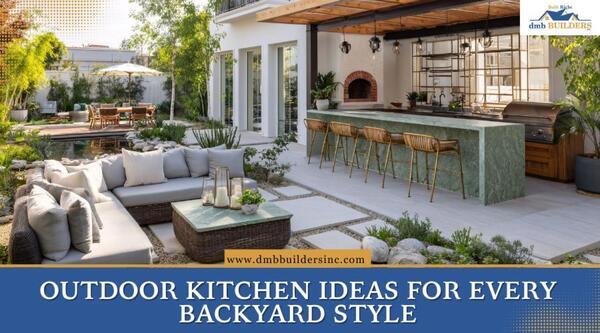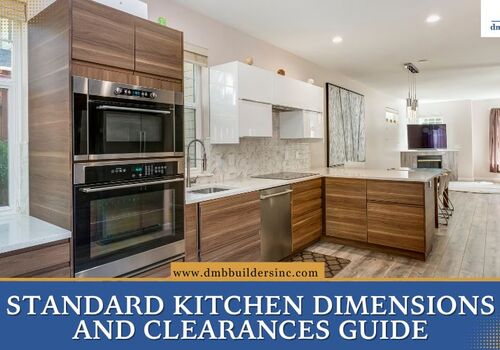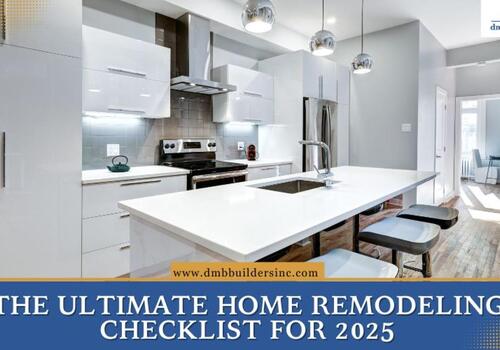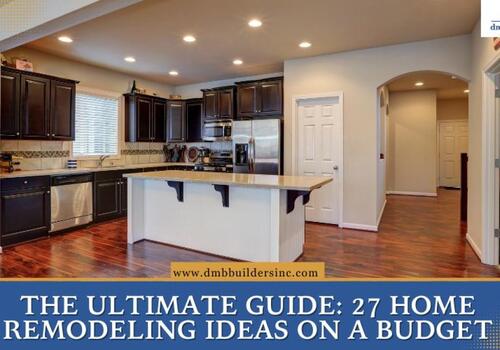Want to transform your backyard into the ultimate entertaining space? The best outdoor kitchen ideas successfully combine smart, functional design with durable, weather-appropriate materials.
This guide provides a complete blueprint for planning your project, covering design trends, material choices, and the key steps that prevent costly mistakes. An outdoor kitchen is the lively heart of a home's social life, transforming a backyard into a true extension of the home and standing as one of the most significant home remodeling ideas available today. It represents grilling on a warm evening, laughter among friends, and lasting family memories.
- What Affects Your Outdoor Kitchen Budget
- 7 Essential Questions to Plan a Flawless Design
- 1. What is Your Outdoor Kitchen's Primary Role?
- 2. Where is the Best Location?
- 3. How Will You Create an Efficient "Outdoor Work Triangle"?
- 4. Have You Planned for Landing Zones?
- 5. How Will Climate Affect Your Material Choices?
- 6. Are Your Utilities Planned from the Start?
- 7. Are You in Compliance with Local Codes?
- Design Inspirations for Style, Layout, and Feature
- Ideas by Style
- Ideas by Layout & Size
- Ideas by Feature
- How to Choose Surfaces Built to Brave the Elements
- Outdoor Countertop Material Comparison
- Outdoor Cabinetry Material Comparison
- Appliances & Features for Outdoor Kitchen Checklist
- The Essentials
- Popular Upgrades
- "Wow" Factor Features
- 7 Costly Outdoor Kitchen Mistakes to Avoid
- From Vision to Reality
- Frequently Asked Questions
- What should every outdoor kitchen have?
- How do you choose the best location for an outdoor kitchen?
- What are the latest trends in outdoor kitchens?
- How do you create a functional outdoor kitchen layout?
- What are the most durable materials for outdoor countertops?
What Affects Your Outdoor Kitchen Budget
Before exploring designs, it's important to understand the factors that shape your project's scope. The final investment is determined by size, material quality, appliance selection, and the complexity of utility installation.
The single most significant factor is the choice between a custom build and a pre-built system. A custom project involves specialized labor and longer timelines, which affects the budget independently of appliance or material choices.
Opting for a high-quality pre-built or modular kit is an effective strategy for controlling project scope and achieving a high-end look.
7 Essential Questions to Plan a Flawless Design
With those basic factors in mind, the next step is to establish a planned blueprint for your design.
A successful outdoor kitchen comes from thoughtful planning, and answering these questions will prevent costly revisions and ensure the final space is both beautiful and highly functional.

1. What is Your Outdoor Kitchen's Primary Role?
The first step is to define the kitchen's main purpose before considering materials or appliances.
Whether it will be a hub for large-scale entertaining or an intimate space for family dinners determines the project's scale. A party-focused kitchen focuses on guest interaction, while a family-focused one may prioritize cooking efficiency.
2. Where is the Best Location?
The placement of your outdoor kitchen has critical practical consequences. Key factors include closeness to the indoor kitchen, access to utilities, and the impact of natural elements.
Pay attention to wind direction to keep smoke away from dining areas, and consider the sun's path when placing shade structures.
3. How Will You Create an Efficient "Outdoor Work Triangle"?
You can create an efficient space by applying the principles of indoor kitchen design. The "work triangle" connects the cold zone (refrigerator), the hot zone (grill), and the wet zone (sink).
A well-designed layout arranges these points in a functional pattern to minimize steps for the cook.
4. Have You Planned for Landing Zones?
You should also plan for dedicated "landing zones." These are clear counter spaces next to key appliances. A lack of adequate counter space is one of the most common design mistakes.
A minimum of 18 to 24 inches of space next to the grill is essential for holding platters and tools.

5. How Will Climate Affect Your Material Choices?
The local climate determines your material choices to ensure long life. A coastal region with salt air requires materials with high rust resistance, like marine-grade 316 stainless steel. Climates with freeze-thaw cycles put materials like tile at a high risk of cracking as moisture expands and contracts.
6. Are Your Utilities Planned from the Start?
Integrating utilities from the project's start is the most cost-effective approach. Adding later gas, water, and electrical connections can involve expensive rework later on. All electrical outlets must be exterior-rated and protected by a Ground Fault Circuit Interrupter (GFCI).
7. Are You in Compliance with Local Codes?
Before finalizing designs, you must research local building codes and any that apply to Homeowners' Association (HOA) regulations.
These rules may dictate setbacks from property lines or require specific permits for gas and electrical work. Following these regulations prevents fines and project delays.
Design Inspirations for Style, Layout, and Feature
With a solid plan in place, the next step is to explore design possibilities. The following ideas are organized by style, layout, and feature to help inspire your perfect backyard oasis.

Ideas by Style
Sleek & Modern
A sleek and modern style is defined by minimalism, clean lines, and an elegant, neutral color palette.
These designs feature handleless cabinetry, integrated high-tech appliances, and materials like poured concrete, quartzite, and stainless steel.
You can also include smart technology, such as Wi-Fi-enabled grills and voice-activated LED lighting systems.
Rustic & Earthy Look
You can achieve this look by embracing natural textures and organic forms to create a warm, inviting atmosphere.
This style mostly features natural stone structures, granite countertops, and accents of weathered teak or Ipe wood. The wood-fired pizza oven is a classic feature, serving as both a cooking appliance and a dramatic focal point.
Coastal & Breezy
This style emphasizes light, airy, and open designs perfect for relaxed entertaining. It uses light-colored stucco or stone finishes, teak cabinetry, and countertops in shades of white or sand.
Coastal designs are perfectly suited for a dedicated outdoor bar and beverage center, which evokes a luxurious, vacation-like feel.
Ideas by Layout & Size
Layouts for Small Spaces
To maximize functionality on a small patio, excellent solutions include galley layouts, L-shaped configurations, and mobile kitchen islands.
These designs keep the essential "work triangle" (grill, sink, refrigerator) compact. You can also incorporate clever ideas like foldable prep stations to add counter space without occupying a permanent footprint.

Layouts for Medium-Sized Backyards
The L-shaped layout is one of the most popular and efficient choices for a standard backyard. It creates a natural workflow and provides ample counter space for landing zones next to the grill and sink.
This design defines a dedicated cooking area while leaving plenty of open space for a dining table or seating area, making it highly functional without dominating the yard.
Layouts for Large, Entertaining-Focused Spaces
For an expansive yard designed for hosting, the U-shaped layout is the ultimate entertainer's design. This layout creates a semi-enclosed hub, allowing the cook to remain part of the conversation.
The generous counter space can accommodate bar-style seating and allows for the integration of luxury upgrades like a pizza oven or a dedicated outdoor bar and beverage center.
Ideas by Feature
Beyond layout and style, incorporating specific features will elevate your kitchen from a simple cooking station to a true entertainment hub.
All-Weather Kitchens for Year-Round Use
To create a kitchen for year-round use, incorporate robust overhead coverage like a pavilion or a modern louvered roof system.
This design allows you to manage sun and rain, extending the usability of your space into cooler months. Integrated patio heaters and built-in fire features also make the space comfortable on cool evenings.
Dedicated Outdoor Bars and Beverage Center
A dedicated zone for drinks is a popular trend that evokes a luxurious, vacation-like feel. These centers often include a bi-level counter to separate prep areas from guest seating.
They are frequently equipped with specialized appliances like wine coolers, kegerators, and high-capacity ice makers.
How to Choose Surfaces Built to Brave the Elements
Seeing these ideas take shape is exciting, but their long life and beauty depend entirely on selecting materials engineered to withstand the outdoors.
A critical and often overlooked factor is UV resistance, as not all durable materials can resist fading from direct sunlight.
For example, engineered quartz contains resins that can yellow with UV exposure, making it a poor choice for uncovered spaces, while natural quartzite is highly resistant.
Outdoor Countertop Material Comparison
| Material | Pros | Cons | Maintenance Level |
| Granite | Exceptionally durable, heat-resistant, and will not fade in direct sunlight. | Porous and must be sealed annually to prevent staining. | Moderate |
| Quartzite | Harder than granite; highly resistant to UV rays, heat, and scratching. | Also porous and requires periodic sealing. | Moderate |
| Poured Concrete | Fully customizable in shape, color, and thickness; extremely durable and heat-resistant. | Highly porous and prone to staining and hairline cracks if not sealed properly. | High |
| Porcelain/Tile | Very affordable with many styles; highly resistant to stains, heat, and UV fading. | Grout lines are prone to staining and mildew; tiles can crack in freeze-thaw climates. | High (due to grout) |
Outdoor Cabinetry Material Comparison
| Material | Pros | Cons | Best For... |
| Marine-Grade Stainless Steel | Extremely durable, clean, and resistant to rust and corrosion. | It can become hot in direct sunlight; it shows fingerprints. | Modern designs and coastal areas where rust resistance is essential. |
| Powder-Coated Steel/Aluminum | Provides a durable finish in a wide variety of colors; adds a protective layer against rust. | The coating can be chipped or scratched. If breached, the underlying metal can corrode. | Achieving a specific, customized color scheme with excellent durability. |
| Teak / Ipe Wood | Offers unmatched natural beauty; dense hardwoods are naturally resistant to rot and insects. | Requires regular oiling to preserve its color; very high cost. | High-end rustic or traditional designs where a natural aesthetic is essential. |
| Outdoor-Rated Polymer (HDPE) | Completely waterproof and resistant to moisture, salt, and chemicals; very low maintenance. | Can feel less premium; prone to damage from high heat, requiring insulated jackets for grills. | Low-maintenance applications, especially suitable in humid or coastal climates. |
Appliances & Features for Outdoor Kitchen Checklist
Once you've selected the basic materials, the next step is to equip your kitchen with appliances that bring your culinary vision to life.
The selection ranges from essential workhorses to luxury upgrades that elevate the entertaining experience.
The Essentials
- High-Performance Grill: The centerpiece of the kitchen and a priority investment.
- Outdoor-Rated Refrigerator: Essential for keeping food at safe temperatures in fluctuating outdoor conditions.
- Functional Sink: A game-changer that streamlines food prep, hand washing, and cleanup.
- Weatherproof Storage: Crucial for protecting tools and supplies from moisture and pests.
Popular Upgrades
- Side Burners: Expand the kitchen's cooking capacity by allowing you to prepare sauces or side dishes off the main grill.
- Pizza Ovens: Adds a fun, interactive, and gourmet element to gatherings.
- Warming Drawers: Very useful for entertainers, keeping finished foods at the perfect serving temperature.
"Wow" Factor Features
- Kegerators & Beverage Centers: Built-in kegerators and multi-zone beverage centers are highly sought-after features.
- Integrated Smart Technology: Smart grills, voice-activated lighting, and integrated sound systems are defining the luxury kitchen.
- Patio Heaters & Fire Features: Built-in fireplaces and infrared heaters extend the usability of the space into cooler months.
7 Costly Outdoor Kitchen Mistakes to Avoid
Equipping your kitchen is exciting, but protecting your investment requires avoiding common pitfalls.
By addressing these potential issues, you can ensure a successful outcome that is both functional and durable.
- Poor Layout & Workflow: A beautiful kitchen that is frustrating to use is a design failure. Neglecting the "work triangle" principle results in an awkward and inefficient cooking experience.
- Wrong Materials: Using indoor-rated materials is a disastrous error. Untreated wood will warp and rot, non-stainless steel will rust, and countertops without UV blockers will fade and discolor.
- Inadequate Lighting: Forgetting about lighting is a common issue. A successful plan incorporates task lighting over work surfaces, ambient lighting for atmosphere, and accent lighting to highlight features.
- Ignoring the Elements: Your kitchen must be designed to manage sun, wind, and rain. This includes providing shade, accounting for wind, and planning for proper drainage to prevent water damage.
- Forgetting Storage: Underestimating storage needs is a common regret. Ample weatherproof storage keeps the space organized and self-contained.
- Insufficient Landing Space: A functional kitchen requires clear counter space next to key appliances. Failing to include a "landing zone" next to the grill severely hampers workflow.
- Utility Afterthoughts: Adding utilities after the structure is built is a very expensive mistake. Proper outdoor kitchen installation ensures all utility requirements are planned for from day one to avoid costly demolition of existing hardscaping.
From Vision to Reality
A world-class outdoor kitchen is a blend of smart design, durable materials, and high-quality construction. It is an investment that enhances your home's value and, more importantly, the quality of life you enjoy there.
By carefully considering the key planning questions and material choices in this guide, you can confidently move from a simple idea to a stunning and practical reality.
Ready to stop dreaming and start designing? Schedule your no-obligation design consultation with the experts at dmb Builders Inc today, and let's build the space where your best memories will be made.
Frequently Asked Questions
What should every outdoor kitchen have?
Every outdoor kitchen should have a high-performance grill, an outdoor-rated refrigerator, a functional sink for cleanup and prep, and sufficient weatherproof storage to protect tools and supplies from the elements.
How do you choose the best location for an outdoor kitchen?
The best location is convenient to the indoor kitchen, provides easy access to utilities like gas and water, and accounts for natural elements. Consider prevailing winds to direct smoke away from guests and the sun's path to plan for adequate shade.
What are the latest trends in outdoor kitchens?
The latest trends include smart technology like Wi-Fi-enabled grills and voice-controlled lighting, dedicated outdoor bars with beverage centers, and gourmet features like wood-fired pizza ovens.
How do you create a functional outdoor kitchen layout?
A functional layout is based on the "work triangle," which ensures an efficient workflow between the grill (hot zone), refrigerator (cold zone), and sink (wet zone). Also crucial is including adequate "landing zones" or counter space next to the grill and sink for staging food and dishes.
What are the most durable materials for outdoor countertops?
The most durable countertop materials are natural stones like granite and quartzite, which are highly resistant to heat and UV fading. Poured concrete is also extremely durable, while porcelain offers excellent stain and UV resistance but can be prone to cracking in its grout lines.





